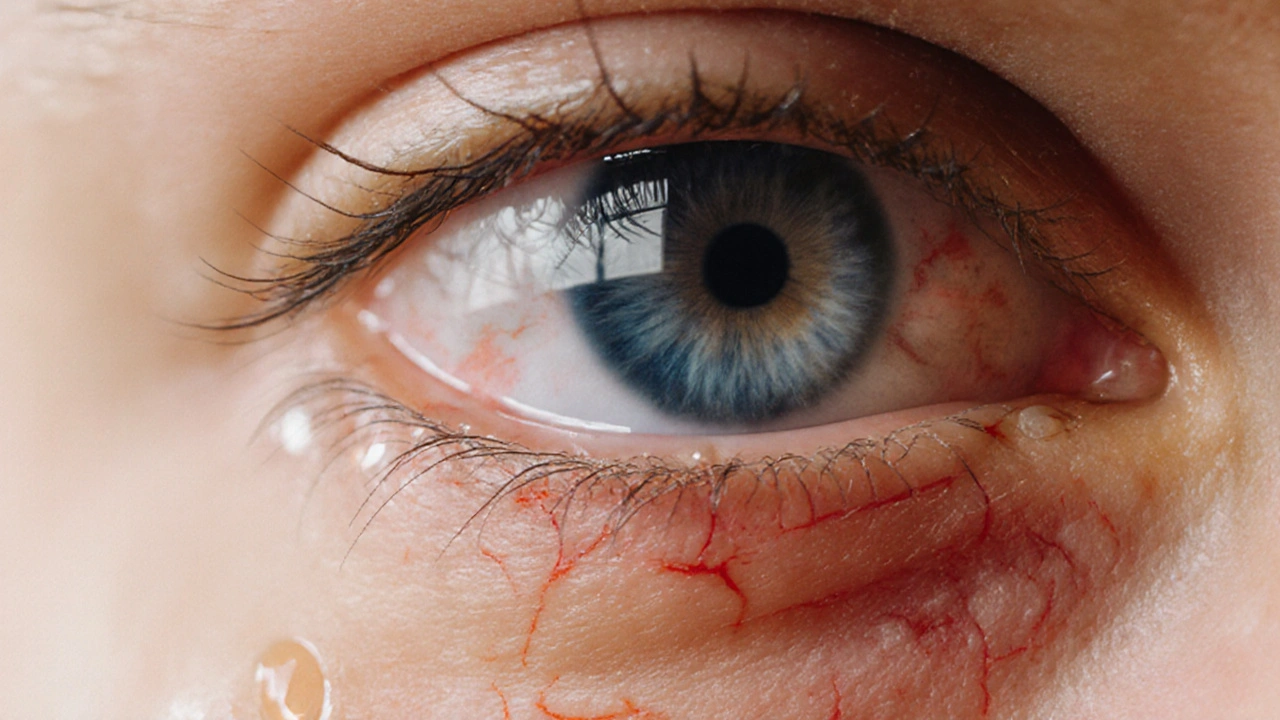Contact Lens Redness Risk Checker
Your Redness Risk Assessment
eye redness can turn a normal day into a painful one, especially when you wear contact lenses. Below is a quick snapshot of what you need to know.
- Identify the most common triggers linked to lenses.
- Learn simple hygiene steps that cut down irritation.
- Spot the red‑flag symptoms that demand a professional check.
- Get a handy checklist for daily lens care.
What is eye redness?
Eye redness is a visible dilation of the blood vessels on the white part of the eye (the sclera). It often signals irritation, infection, or an allergic response. While occasional minor redness is harmless, persistent or painful redness deserves attention.
Why contact lenses can make your eyes red
Contact lenses sit directly on the cornea, the clear front surface of the eye. This close contact means any change in lens condition, fit, or hygiene can quickly affect the ocular surface.
Contact lenses are thin, flexible discs made from hydrogel or silicone hydrogel that correct vision by refracting light onto the retina. They rely on a thin tear film to stay moist and comfortable.
When the tear film breaks down, the eye’s protective mechanisms kick in, causing the vessels in the conjunctiva to expand-hence the redness.
Common conditions that cause redness while wearing lenses
- Dry eye syndrome occurs when the tear film evaporates too quickly or isn’t produced in sufficient quantity. Lens wear can exacerbate this by absorbing tears.
- Allergic conjunctivitis is an immune reaction to pollen, dust, or even lens cleaning agents. It leads to itchiness, swelling, and reddening.
- Bacterial keratitis is a serious infection of the cornea, often linked to contaminated lenses or solutions. Redness is usually accompanied by pain, discharge, and blurred vision.
- Mechanical irritation from a poorly fitting lens or debris trapped under the lens can also cause localized redness.
Lens hygiene: the single most effective way to stay clear
Good hygiene isn’t just about washing your hands-it's a routine that protects the eye’s delicate ecosystem.
- Wash hands with soap and dry with a lint‑free towel before handling lenses.
- Never reuse a solution; discard old solution each time you store lenses.
- Rub and rinse lenses gently, even if you use a “no‑rub” solution.
- Replace the lens case every three months and keep it open to dry.

Choosing the right solution: a quick comparison
| Feature | Hydrogen Peroxide | Multipurpose Solution |
|---|---|---|
| Disinfection Power | High - kills bacteria, fungi, Acanthamoeba | Moderate - relies on preservatives |
| Cleaning Action | Requires neutralizing case; no rubbing needed | Can be used with or without rubbing |
| Risk of Irritation | Low if neutralized properly | Higher for sensitive eyes (preservatives) |
| Convenience | Extra step - neutralization | All‑in‑one, easy for daily wear |
For people prone to redness, many eye‑care professionals recommend hydrogen peroxide systems because they eliminate preservative‑related irritation.
Lens material and fit: why they matter
Silicone hydrogel lenses allow more oxygen to pass through to the cornea than traditional hydrogel, reducing hypoxia‑related redness.
Even the best material won’t help if the base curve or diameter is off. A lens that rides too high can trap debris, while one that sits too low can rub the conjunctiva.
When to remove lenses and see a professional
Redness isn’t always an inconvenience; sometimes it’s a warning sign.
- Persistent redness lasting more than 24 hours.
- Pain, burning, or a gritty sensation.
- Visible discharge, especially yellow or green.
- Blurred vision that doesn’t improve after removing lenses.
- Sensitivity to light (photophobia).
If any of these appear, remove the lenses immediately, switch to glasses, and book an eye‑care appointment.
Quick daily checklist for red‑free lenses
- Check lens for tears, deposits, or deformation before insertion.
- Ensure hands are clean and dry.
- Insert lenses gently; avoid touching the cornea directly.
- After wear, clean, rub, and store lenses in fresh solution.
- Inspect case for cracks; replace every three months.
Following this routine slashes the odds of irritation by more than 50% according to a 2023 clinical survey of 2,300 soft‑lens wearers.
Frequently Asked Questions
Can I wear contacts if I have dry eye?
Yes, but choose a high‑oxygen silicone hydrogel lens, use preservative‑free drops, and limit wear time to 6‑8 hours until your tear film improves.
Are daily disposables better for preventing redness?
For many, daily disposables eliminate the need for cleaning solutions, reducing exposure to allergens and preservatives. They’re a solid option for sensitive eyes.
What’s the difference between allergic conjunctivitis and infection?
Allergy usually causes itching, watery discharge, and both eyes are affected. Infection often brings pain, thick yellow/green discharge, and may start in one eye.
How often should I replace my contact lenses?
Follow the schedule from your eye‑care provider: daily disposables - every day; two‑week lenses - every 14 days; monthly lenses - every 30 days. Ignoring the schedule raises infection risk.
Can makeup cause eye redness with lenses?
Yes. Powdery eye shadows and mascara can flake onto lenses, irritating the conjunctiva. Apply makeup after inserting lenses and avoid glittery products.






Mark Wellman
2 October, 2025 . 13:59 PM
Man, I gotta tell ya, dealing with eye redness while wearin contact lenses is like a never‑ending drama series that just wont quit. I wake up, grab my case, and already feel that throbbing irritation like a tiny alarm clock in my cornea. The whole routine feels like a ritual you cant escape – wash hands, pop the lenses, hope the tear film does its thing without betrayin you. Every time I skip a case replacement, it's like invitin a germ party to my eye socket, and the redness shows up faster than my inbox on a Monday morning. I read the article and it basically lists the same old tips that most of us already know, but somehow we keep messin up anyway, like we enjoy the pain. Maybe it's the laziness, maybe it's that emotional vampire inside me that craves the drama of a red eye at the worst possible moment. The preservatives in multipurpose solution? Yeah, they can be a sneaky irritant, especially if you’re prone to allergies – think of it like an undercover agent wreaking havoc. And don't even get me started on the silicon hydrogel lenses that promise more oxygen but still end up feeling like a sandpaper curtain on the cornea if you wear them too long. The article mentions hydrogen peroxide solution is low‑irritation, but honestly most folks just dont want the extra step of neutralizing it, so they stick with the easy‑pick‑multifunctional stuff and wonder why their eyes look like a tomato. Then there’s the whole makeup debacle – glittery shadows and mascara flakes are like tiny confetti that get stuck under the lens, turning your eye into a red‑flagged disaster zone. I swear, every time I forget to replace my case every three months, it's like the universe is remindin me that I’m playing with fire. The suggested daily checklist sounds like a NASA launch procedure; who has time for that when you're already late for work? Yet, somehow, skipping any step just multiplies the risk, and before you know it you're sitting in the waiting room of an eye doctor with a red, sore eye that feels like it’s on fire. So yeah, the article is right – good hygiene is the single most effective weapon, but most of us are too lazy or too busy to actually follow it. In the end, you either keep your eyes clear or you keep going back to the pharmacy for those over‑the‑counter drops that only mask the problem for a few hours. Bottom line: if you love your eyes, stop treating them like a second‑hand market and actually respect the routine, or be prepared to live with that constant, annoying redness that makes you look like you’ve been crying all night.
Amy Morris
3 October, 2025 . 23:19 PM
I completely understand how overwhelming it can feel when the simple act of inserting lenses becomes a source of constant irritation. Your vivid description really captures the frustration many of us experience, especially when we inadvertently skip a step in our routine. It’s crucial to remember that consistent case replacement and using preservative‑free solutions can dramatically reduce that red‑eye drama. Even a small adjustment, like opting for a hydrogen peroxide system, may provide the relief you’ve been seeking.
Francesca Roberts
5 October, 2025 . 08:39 AM
Honestly, the article sounds like a checklist for people who think they're plumbing experts. If you’re still using multipurpose solution without ever rubbing, you’re basically courting bacteria. Switching to a hydrogen peroxide system isn’t rocket science; it just kills the bugs you’re inviting every night. Try it before you blame "eye redness" on your soul.
Becky Jarboe
6 October, 2025 . 17:59 PM
From a clinical optics perspective, the tear film stability index is directly correlated with lens material oxygen transmissibility. Silicone hydrogel lenses with a Dk/t > 150 typically mitigate hypoxic redness, yet improper case hygiene nullifies that benefit. Incorporating a bi‑daily lens cleaning protocol, especially with enzymatic solutions, can lower microbial colonization rates by up to 70%. Moreover, evaluating the base curve deviation using keratometry ensures mechanical irritation is minimized.
Carl Boel
8 October, 2025 . 03:19 AM
Look, the American eye‑care standards are clear: disregarding proper lens hygiene is a betrayal of personal responsibility. Our nation’s health depends on citizens who follow guidelines, not on those who think “I know better” and ignore case replacement schedules. Preservative‑free drops are not a luxury; they're a necessity for preserving ocular integrity. When you compromise on these basics, you’re essentially inviting preventable infections that burden our healthcare system. It’s high time we stop glorifying laziness in the name of convenience.
Shuvam Roy
9 October, 2025 . 12:39 PM
Thank you for highlighting the importance of adhering to proper lens care. It is commendable to prioritize eye health by adopting rigorous hygiene practices. By replacing cases regularly and selecting appropriate solutions, we can safeguard our vision effectively. I encourage everyone to view these steps as essential investments in long‑term ocular wellness.
Jane Grimm
10 October, 2025 . 21:59 PM
While I appreciate the thoroughness of the guide, it egregiously overlooks the fact that most readers neglect even the most elementary steps. The insistence on “daily checks” reads as patronising to an audience capable of understanding basic hygiene. Moreover, the recommendation to replace lens cases every three months is a mere suggestion that should be mandated. Failure to comply inevitably leads to ocular pathology, a fact that cannot be overstated.
Nora Russell
12 October, 2025 . 07:19 AM
The piece exhibits a conspicuous lack of academic rigor, relying on anecdotal assertions rather than peer‑reviewed ophthalmologic data. Its prose is riddled with simplistic exhortations that betray a superficial grasp of corneal physiology. In addition, the omission of statistical prevalence rates for keratitis undermines its credibility. A more sophisticated analysis would juxtapose solution efficacy with microbial load metrics, thereby affording readers a comprehensive perspective.
Craig Stephenson
13 October, 2025 . 16:39 PM
Great reminder to keep those lenses clean!
Tyler Dean
15 October, 2025 . 01:59 AM
Don't be fooled – the big lens corporations hide the real risks to keep profits high. The truth is out there, stay vigilant.
Susan Rose
16 October, 2025 . 11:19 AM
Eye health is a universal concern, and sharing best practices helps bridge cultural gaps. It's fascinating how different regions approach lens hygiene, yet the fundamentals remain the same. By respecting each other's experiences, we can all benefit from a clearer vision. Keep spreading the knowledge!
diego suarez
17 October, 2025 . 20:39 PM
Indeed, fostering a community dialogue about lens care can empower individuals to make informed choices. While the article offers solid basics, personalizing the regimen-considering factors like climate, lifestyle, and existing eye conditions-can further reduce redness. Moreover, consulting an eye‑care professional periodically ensures that any subtle changes are caught early. Let’s continue supporting one another with practical tips and respectful feedback.